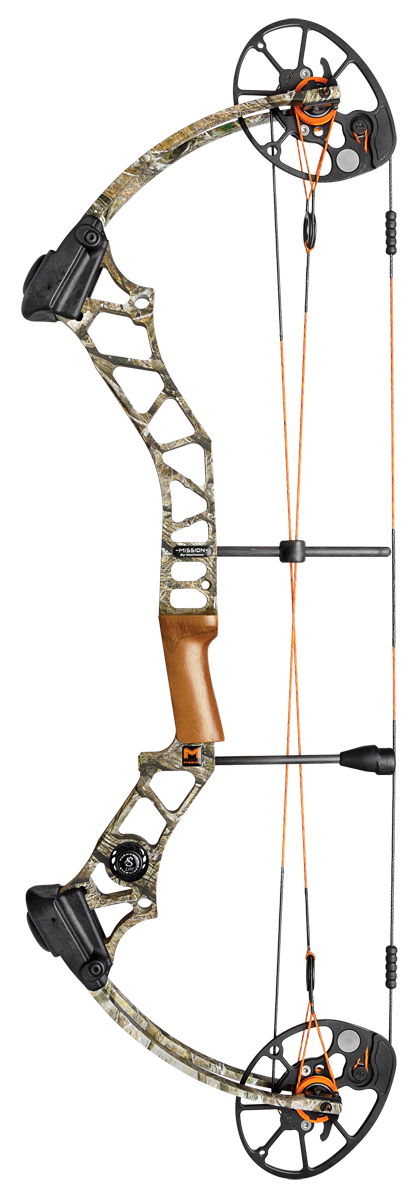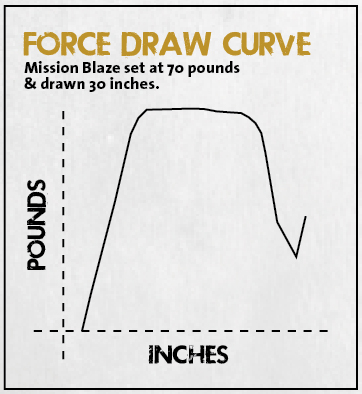It’s difficult to avoid comparisons between Mission’s new Blaze and its immediate predecessor, the highly successful Ballistic, which is still in the Mission line-up for 2014. Both bows are driven by Mission’s AVS (Advanced Vectoring System) Cams. We described these in our test of the Ballistic; suffice it here to say they were originally used on Mathews’ McPherson line of bows and represent a very sophisticated and effective cam design. In the case of the Blaze, the AVS cam is augmented by perimeter weights, another Mathews innovation. Overall bow design is very similar; the extruded risers appear to be identical. The split quad limbs are similar as well, and the limb pockets appear to be the same, though in the case of the Blaze the take-off angle of the limbs is less sharp, resulting in an axle-to-axle length that is 33 inches compared to the 30.5 inches of the Ballistic. Mass weight of the bows, not  surprisingly, is an identical 4.18 pounds. Grip on the Blaze is walnut, as opposed to the composite grip of the Ballistic.
surprisingly, is an identical 4.18 pounds. Grip on the Blaze is walnut, as opposed to the composite grip of the Ballistic.
From the shooter’s perspective, probably the most significant difference between the Blaze and the Ballistic will be the Blaze’s top speed of 340 fps, making it 10 fps faster than its predecessor. That also makes it Mission’s only real entry in the speed bow category. There are faster bows to be sure (aren’t there always?), but 340 fps is plenty fast.
Available in Lost Camo AT or Black, fit and finish are excellent, though the bulky, composite limb pockets seem inconsistent with the very light, sleek appearance lent by the thin split quad limbs, and the walnut grip, while an improvement over the Ballistic’s composite grip, seems similarly oversized and, well, a little clunky.
A varying but generally wide range of draw weight adjustment is a hallmark of Mission bows, and with a peak weight of 70 pounds adjustable all the way down to 50 pounds, the Blaze is no exception. Draw weight is adjusted by simply turning the limb bolt. Draw length is module-specific in half-inch increments. It can be adjusted without pressing the bow, simply by removing the modules and replacing them with a different size.
Shooting The Bow
Setting up the bow was uneventful. The QAD Ultra-Rest fits well and on this riser offers more than adequate vertical and horizontal adjustment. As with other Mathews and Mission bows, recommended center shot is 13⁄16 inch from the riser, the arrow aligned with the Berger holes on the vertical axis. This provided good arrow flight, and with a few sight pin adjustments, the bow was shooting very tight groups right away.
After the overall design and appearance, the grip is probably the first thing I notice upon picking up a bow. Preferences in grips are very personal. On the plus side for the grip on the Blaze, I like the feel and appearance of a wood grip; they’re slick and less prone to induce torque, and they’re warm in cold weather. At the same time, shooters who prefer a skinny or more ergonomic grip will want to modify or replace this one, as it offers neither of those qualities.
At 340 feet per second, the Blaze is a fast bow. The draw is fairly smooth; the drop-off is a little sudden, but nothing harsh. As mentioned, both the Blaze and the Ballistic make use of the AVS cam system, so not surprisingly the feel is very much the same. The 10-fps difference in speed is due in large part to the Blaze’s skinnier brace height of just a tad over 6 inches, compared with the 7-inch brace height on the Ballistic, though perimeter weighting of the Blaze cams may contribute a little to the higher speed as well. The slightly longer axle-to-axle length of the Blaze may be noticeable to some shooters at longer draw lengths, but for most it will probably be insignificant.
The shot, as well as the draw, is smooth. As previously mentioned, the limbs on the Blaze are less close to parallel than is the case for the Ballistic, which prompted me to look for more in the way of recoil from the Blaze. If it’s there, I was unable to detect it. There is a very slight amount of vibration after the shot, probably noticeable only if you’re looking for it. (On reviewing notes from testing the Ballistic, I made a similar comment about that bow.) This is a very quiet bow—some might say surprisingly so given that it relies on a single harmonic damper on the riser, a single string stop of an older design, and a couple of discreetly small rubber string silencers to suppress noise. The suggested retail price of $599 qualifies it as moderately priced, and its speed of 340 fps, together with smooth and quiet shooting, should make it a popular addition to Mission’s line-up. Any bowhunter seeking high performance in a moderately priced bow should put the Blaze on a short list of bows to consider.

Mission Blaze Specs
Letoff: up to 80%
Brace Height: 6.125 inches
Weight: 4.18 pounds
Axle-To-Axle Length: 33 inches
Speed: up to 340 fps
Draw Lengths: 26 to 30 inches, module-specific in half-inch increments
Draw Weights: 70 pounds peak, adjustable down to 50 pounds
Options: Lost Camo AT or Black finishes. Accessory packages including Basic, Bow Hunter, and Pro Hunter
Suggested Retail: $599 bow only
Objective Tests (30 Inches Draw)
Peak Hold*: 70 pounds
Weight, Full Draw*: 13.0 pounds
*Rounded to nearest half-pound
At 70-Pound Draw Weight
| Arrow Weight | Speed @ Launch | Speed @ 20 Yards | K.E. @ Launch | K.E. @ 20 Yards |
| 385 grains | 315 fps | 307 fps | 84.9 ft. lbs. |
80 ft. lbs. |
| 500 grains | 282 fps | 276 fps | 88.1 ft. lbs. | 85.1 ft. lbs. |
At 60-Pound Draw Weight
| Arrow Weight | Speed @ Launch | Speed @ 20 Yards | K.E. @ Launch | K.E. @ 20 Yards | Sound Level |
| 385 grains | 289 fps | 282 fps | 71.5 ft. lbs. | 68 ft. lbs. |
58.3 dBA |
| 500 grains | 254 fps | 248 fps | 71.5 ft. lbs. | 68.5 ft. lbs. | 46.9 dBA |






